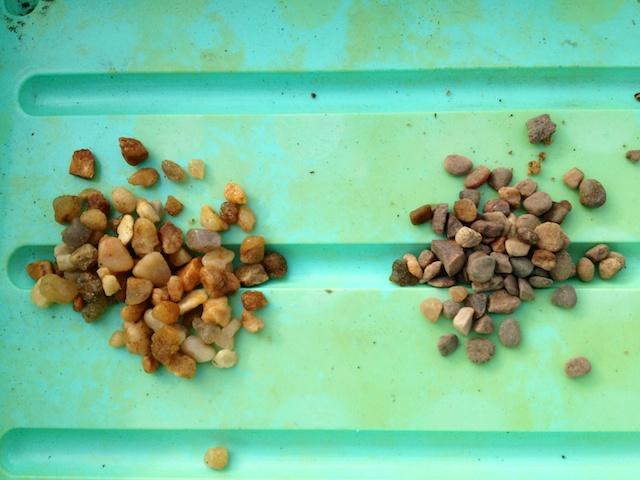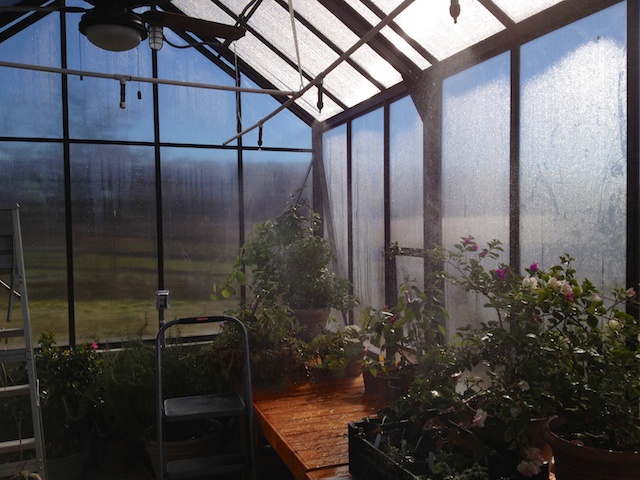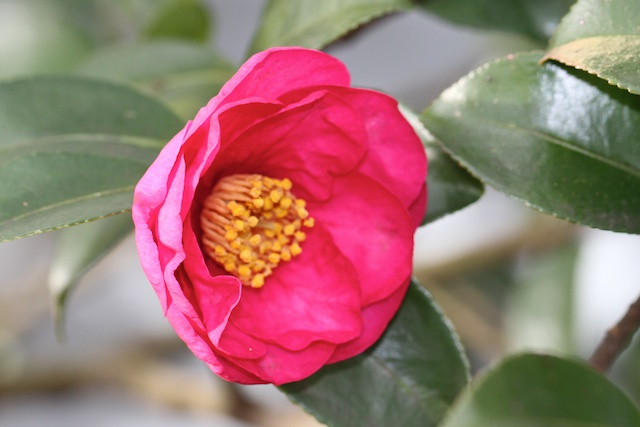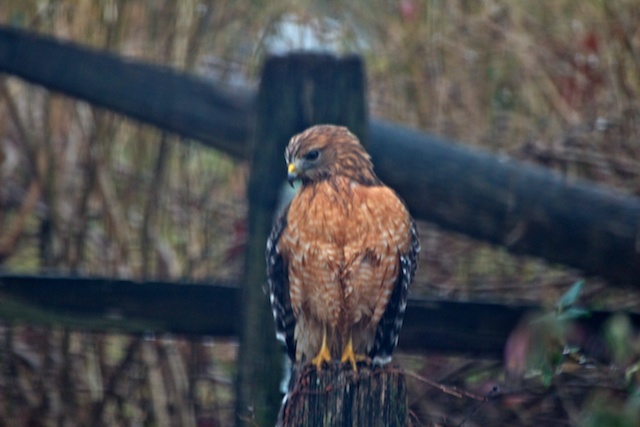
This is from an advertisement for horticultural grit in England
There is a wonderful posting on seed sowing on the Scottish Rock Garden Club website. Not for the first time I observed the casual use of the term ‘horticultural grit’. In England, where practically everyone is a gardener, you can expect that they would have a specialized soil ingredient for top dressing seedlings and alpines. For us, in the U.S., the search is more difficult.
I bought some bulbs recently from Telos Rare Bulbs that are from California and South Africa so I thought I would try to follow up on this idea of using small rocks as a top dressing. I have often used mulch as a finish dressing in pots to prevent the soil from washing out when I water. It has the disadvantage of getting crusty over time and not letting the water actually penetrate. My local nursery had a product called Mosser Lee Soil Cover (river stone) which was sort of along the lines of what I was looking for. But it was $1 a pound and not all that much different from the bulk pea gravel that the nursery sold in a plastic bag at 10 cents a pound.
So I took the less expensive approach and used the pea gravel with my Telos bulbs.
But I still wanted to find a finer scale gravel at bulk prices. So I consulted the web, naturally. I found a long thread on Garden Web trying to track down something called Al’s gritty mix. I discovered that there were people all over the country trying to solve this same problem. My efforts led me to the local feed store in Frederick where I bought three different sizes of granite that is used for raising chickens. The product comes from North Carolina and is called Gran-I-Grit. The 40 pound bags cost $6 apiece and have pretty much given me a range of options now.
Another nice discussion of soil mixes and planting techniques that refers specifically to the use of chicken grit is from Tom Clothier on HortNet.
Lest you think that I have wandered off into the gravel mining industry I also did a few other things this week. I’ve completed the overhead watering system for the greenhouse which will make it possible to travel when necessary…
And I did get outside to take advantage of some of the extended fall weather we’ve had. I finally put in the garlic which was well overdue for planting…
And I’ve almost finished up with this year’s bulb planting, only about another 60 daffodils to go. There are 40 new daffodils in the ground in addition to 55 tulips and 200 smaller bulbs. I did some weeding this week too wherein I discovered that the Snowdrops are emerging (which is fine) but the Adonis is coming up too (which is not fine). I put some compost on top of the Adonis to try to keep it from putting it’s flower up too soon, which it did last year prior to a hard freeze …
Garden Blogger’s Bloom Day for September 2012
Well my lead Garden Blogger’s Bloom Day flower for this month is one of those potted plants that looks wonderful at this time of year, but only if it has a place to live over the winter. For years I’ve kept it in the basement and it takes the better part of the year to get back to flowering strength. This brings me to the major thing that is growing around here right now — a greenhouse is well underway which will allow us to provide a happy dwelling place for the bougainvillea and other plants of a more southerly persuasion.
This is a 10′ x 14′ BC greenhouse and, as you can see, it sits well up on a solid kneewall that should allow for tall plants and hanging vines. Inside the greenhouse I’m planning wooden benches, electricity, and even the kitchen sink.
So while that’s clearly been my focus for the last few weeks there are some other flowers worth sharing.
The Turtlehead ‘Hot Lips’ is living up to it’s name.
I swear it puckered up for the picture.
The Dahlias are enjoying there staring role for the season. Bishop of Llandaff is always great to see with its dark foliage.
A new one for us is the compact Dahlia ‘Extase’.
A striking addition to the rose garden is a ‘Black and Blue’ Salvia which hasn’t been intentionally planted there for three years.
This was really a delightful surprise and a reminder of how nice that deep blue color is.
The Loropetalum continues to please.
I will close this month’s Bloom Day observations with a lovely Toad Lily that I got from Plant Delights this spring.
Garden Blogger’s Bloom Day for December 2011
Well in contrast to two weeks ago there is actually very little blooming outside for this months Garden Blogger’s Bloom Day. So that’s why I chose to lead off with a spectacular new little Phalaenopsis which graces our kitchen counter at the moment. This is a recent purchase but all the old orchids are coming into bloom right now so we’re in the midst of kind of an orchid frenzy which may go on for weeks (one of the nice things about orchids). The red Cattleya is another especially striking specimen — and it has a marvelous fragrance as well.
Outside one of the few flowering elements is the red Camellia sasanqua which can be found in flower just about every year at this time.
There’s also a Verbena hanging on in a pot by the driveway that doesn’t realize it should have died back long ago.
What I find particularly remarkable are a patch of Allium that we are growing here for the first time. The Allium thunbergii ‘Ozawa’ did not bloom until October but they were absolutely striking when the appeared. Now, two months later we still have the pleasure of their pink blossoms. They are more like dried pink blossoms but lovely nonetheless. This is a real winner.
There would also be pictures of the Snowdrops to share, but some critter (I suspect deer) chopped all the snowdrop flowers off. In addition they are chewing on blueberries that have never had any animal damage in the last thirty years. I’m contemplating building a new house that is of Roman design with a totally walled exterior and a large central atrium, say about 7 acres in size, that is not accessible to deer.
I would also like to note that the Calendula in the herb garden are poised, buds at the ready, waiting for the slightest thaw.
And as a final farewell to this day let me share the Miscanthus ‘Morning Light’ which still has it’s seed heads waving in the wind. It’s another plant with a long season of delight.
I encourage you to visit the center point for all Garden Blogger’s Bloom Days at May Dreams Gardens and see what other gardeners have to share.
Belated Garden Blogger’s Bloom Day
Well, not only am I late with assessing the mid-Winter blooms but I have little to add in terms of flowers for this day. The Bougainvillea above is one of two that have been flowering since November. Now that is not surprising for people in California, Texas, or Florida. But in Maryland it’s definitely a more anomalous occurrence. Some plants respond better than others to lavish exposure to sun and water in the warmer months and then the subsequent trip to the dungeon for the winter. Those which do flower under such treatment get to live in the sunlit dining room for as long as they hold forth. The Bougainvilleas seem to have gotten the message. This is the best they have ever flowered in many years of mistreatment.
Outside, however, we are still limited to the lovely snowdrops which I mentioned in my last post. You would think that someone else would follow their example. If one looks outside it’s not too promising.
While temperatures are typically in the thirties, on a sunny day you can talk yourself into looking about for signs of spring. Indeed the daffodils near the deck are poking their way up above the ground.
But realistically nothing is likely to happen until we can more reliably see days in the 40’s. Year after year I look for the first crocus just about 5 weeks from now, when the pitchers and catchers report for the beginning of the baseball season and my oldest son has his birthday — all three very momentous events. In between we can expect to see the witch hazel start to show some color, the buds on the Magnolia start to pop, the winter aconite begin to show some color, and, if we are very good to one another, the first buds from the adonis.
In the meantime, we will say goodbye to the now fading Miltonia Orchid which has been sharing its blooms with us since Christmas.
If you would like to see what other gardeners are seeing in their gardens right now I encourage you to go to Carol’s Garden Blogger’s Bloom Day report.
Or you can settle back with your seed catalogs spread out on the table and read Marianne’s delightful take on the winter landscape in her small town garden column in today’s Frederick Post.
The December Drearies
It has been a dreary start to December with temperatures 12 degrees below normal on average and a number of cloudy days. It even snowed briefly last Friday with just enough slickness to it that cars careened off the road all over the city. We live on a hill so that getting down or up on such days can be a dicey proposition. In such conditions it’s nice to see flowers wherever you can and the coleus that Beth took a cutting from more than a month ago has obliged by putting up lovely lilac flowers. If coleus were difficult to grow or expensive to acquire I’m sure we would go overboard trying to acquire it from exotic nurseries. However, it is ridiculously easy to grow from seed and widely available in nurseries so I confess we often fail to give it full coverage in describing its impact in the house and garden.
Coleus was one of the first plants we ever intentionally grew back in our student housing days at UC Riverside. We were fascinated by the different variations in leaf color and propagated a great many of them. As time went on, we moved to more challenging plants and neglected the coleus as too common. The last few years, however, we’ve been rediscovering the impact of coleus in the garden. As an annual it grows quickly to 2 – 3 feet tall and can be kept thick and bushy in containers or in the soil. The cut leaves last a very long time in indoor arrangements, sometimes to spectacular effect. Perhaps if we thought of them in terms of their new botanical moniker, Solenostemon hybrids, we would give them more respect.
As I was working at the computer on a particularly rainy afternoon yesterday, I looked out to see a good-sized hawk sitting on the fence outside my window.
I apologize for the poor quality image which was taken in poor light and through a rain spattered window, but what I found remarkable as I followed this hawk about the yard is that the hawk had no interest in the hundred or so birds and many squirrels that were flitting about our feeders. Instead, he was actively harvesting the worms that were surfacing because of the water in ground. It was very much like a robin on steroids. Perhaps worms are seen as epicurial delights in the world of raptor dining. Note to self — the camera should be kept in bird picture ready mode at all times, not left as though one had just taken multi-second timed exposures of coleus flowers in the house.
December is when we tend to review our donations for the year and, like Santa Claus, decide which charities have been naughty and nice. Sometimes charities, the Nature Conservancy comes to mind, get tangled up in their own misplaced executive extravagances, and we have to punish them by withholding our giving for a while. One place that we have never felt the slightest reservation about recommending is Able and Willing International Education Foundation. We know the founders, Puma Mbuyu Wa Mbuyu and Ruth Snyder, who began this effort in the Congo with their own time and money in 1995. Beginning from scratch they have built schools in two villages that now serve 661 students over all grades.
In the process they’ve brought electricity and an ethic of self-reliance to the area. In Puma’s words, “More than simply constructing the buildings, AWIEF helps to establish the programs that enable schools to support to themselves. In doing so, the organization seeks to model a healthy process of development that promotes self-reliance and helps to break the cycle of dependency on foreign aid.” Nowhere else have we seen such a dramatic impact of our contributions put to effective use.
February begone — welcome Hippeastrum
This has been the most amazing February on record. Very few blades of grass to be seen all month. I can actually look back and note years when we have tilled the garden in February but this year has seen snowfall after snowfall. At long last the Amaryllis (Hippeastrum) have come into bloom to add some flowerful color to our lives.
Even the Amaryllis seem to have been delayed this year past their normal appearance. I usually take the cue from the plants and don’t try to force their pace. But once they start to grow they get lots of light and water. Though somewhat retarded in time they have put forth a solid set of blooms.
Though widely known as Amaryllis the flowers we grow under that name are more properly Hippeastrum. There are 70 species and over 600 cultivars and I’ve long since lost the names of the two particular ones that we grow. They respond well to living on the outside during the summer then a dry dormancy at the end of the fall where they live in the dry basement. In December we start watering gently again and wait for some sign of growth. They flower for an extended period of time and they’re well worth the small effort to grow them.
Outside I’m seeing increasing patches of green. The crocus are showing above ground in the spots where the snow has melted — there is still a foot or more of snow in many places— but they would still like to have some warmer weather before granting a bloom.
And in the garden bed where the most of the snowdrops live, the same snowdrops that appeared in January are still hanging in there. A bit bedraggled from living under the snowpack, but flowering nonetheless. I am becoming a real admirer of these little bulbs.




































